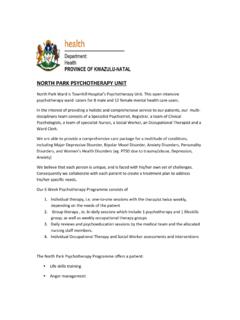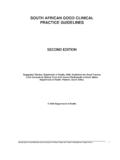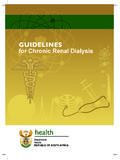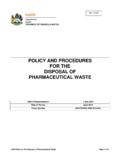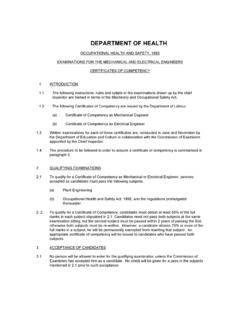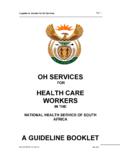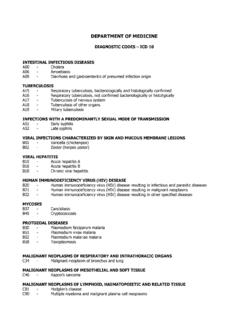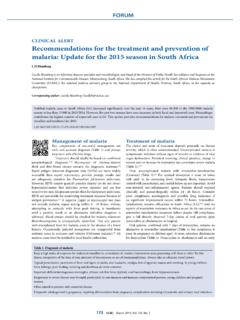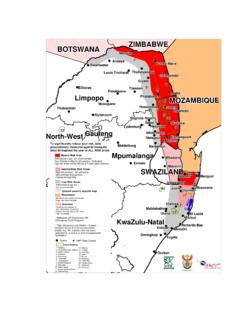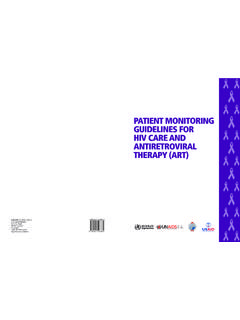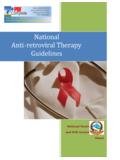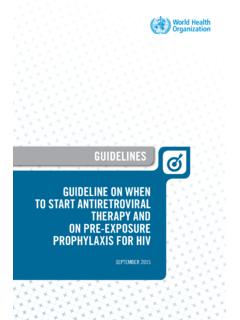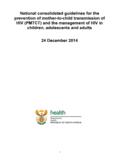Transcription of Southern African HIV Clinicians Society Clinical ...
1 Southern African HIV Clinicians Society Clinical guidelines antiretroviral therapy in adults 1. Goals of therapy The primary goals of antiretroviral therapy are: maximal and durable suppression of viral load; restoration and/or preservation of immunological function; improvement of quality of life, and reduction of HIV-related morbidity and mortality. This is achieved by suppressing viral replication as intensely as possible for as long as possible by using tolerable and sustainable treatment for an indefinite period of time. By doing so, the impact of HIV on the immune system may be minimised and the morbidity and mortality associated with HIV-infection can be improved. Effective therapy has been shown to reduce the number of new cells infected by HIV and to impede the ability of the virus to evolve drug-resistance.
2 Introduction The magnitude of HIV infection in Southern African and the number ofimpoverished people who desperately need antiretroviral therapy (ART) butwho will never received this, is overwhelming, and unparalleled in the historyof infectious diseases. Lifetime costs associated with antiretroviral therapyand political intransigence remain the most important obstacles to adequatemanagement of HIV infection in many countries including South Africa, wherethe availability of finance determines access to therapy . While the SouthernAfrican HIV Clinicians Society endorses the right of all HIV-infected adults andchildren to receive standard of care, it also acknowledges the seriousconstraints influencing individual s access to effective therapy .
3 The Southern African HIV Clinicians Society endorses the right of all HIV-infected adults and children to receive an optimal standard of care andsupports all initiatives that improve access to effective therapy . As knowledge and understanding of the use of antiretroviral therapies is stillevolving and new therapeutic agents become available guidelines arereviewed and updated regularly. The most current version should always beconsulted. 2. Standard of Care Maximally suppressive antiretroviral regimens (Highly Active antiretroviral therapy HAART) should be used whenever possible in order to obtain the best Clinical results and to prevent resistance. Single drug regimens (monotherapy) Monotherapy should not be used in the treatment of HIV-infection, however, it continues to play a very important role in the prevention of mother to child transmission (MTCT).
4 Dual drug regimens Dual therapy is moderately effective, but is unlikely to produce long term durable benefit in most patients. It is not the standard of care, but is considerably better than no therapy and should be considered in patients unable to afford HAART. This should only be applied to patients who have already developed AIDS. In this setting, dual therapy is better than no therapy otherwise resistance is a major concern if dual nucleoside therapy is prescribed to asymptomatic patients. The efficacy of two drug combinations (dual therapy is greater than monotherapy potentially achieving a log reduction in viral load). Note that triple combinations are the standard of care. Triple combinations The combination of three synergistic antiretroviral agents remains the standard of care; substantial reductions in medication prices continue to make triple-drug regimens more affordable.
5 3. Classes of antiretroviral agents and their mechanisms of action Currently available antiretroviral agents inhibit one of two key viral enzymes required by HIV for intracellular viral replication: reverse transcriptase, which is essential for completion of the early stages of HIV replication, and protease, which is required for the assembly and maturation of fully-infectious viral progeny Classification of antiretroviral agent Abr. Enzyme Inhibited Specific action Nucleoside reverse transcriptase inhibitors NRTIs Reverse transcriptase mimics the normal building blocks of HIV DNA Non-nucleoside reverse transcriptase inhibitors NNRTIs Reverse transcriptase directly inhibits reverse transcriptase Protease inhibitors PIs Protease inhibits late stages of HIV replication.
6 4. antiretroviral agents currently available in South Africa Note: Always refer to the most current version of the guidelines as new treatments regularly become available for Clinical use (see below). GENERIC NAME TRADE NAME CLASS OF DRUG zidovudine (AZT) Retrovir * NRTI didanosine (ddI) Videx * NRTI zalcitabine (ddC) Hivid NRTI lamivudine (3TC) 3TC * NRTI stavudine (d4T) Zerit * NRTI abacavir Ziagen * NRTI nevirapine Viramune * NNRTI efavirenz Stocrin NNRTI nelfinavir Vira-cept * PI indinavir Crixivan PI ritonavir Norvir * PI saquinavir (hard gel formulation) Invi-rase PI saquinavir (soft gel formulation) Forto-vase PI amprenavir Preclir * PI Lopinavir/ritonavir Kaletra PI * Available in paediatric formulations 5. Major side effects and complications of classes of antiretroviral agents The tolerability of antiretroviral regimens remains one of the important determinants of treatment success.
7 Some of the more common currently recognised side effects and complications of these agents are listed below. The consequences of changing antiretroviral therapy need to be carefully considered before substituting or stopping specific agents. SIDE EFFECT / COMPLICATION NRTI NNRTI PROTEASE INHIBITORS Myelosuppression Yes No No GI Intolerance Yes Yes Yes Pancreatitis Yes No No Peripheral Neuropathy Yes No No Allergic Reaction Rare potential for hypersensitivity reaction with abacavir Yes Rare Lipoatrophy Yes Unknown* Unknown* Lactic acidosis Yes No No Lipodystrophy Yes Unknown* Yes Raised cholesterol & triglyceride Unknown* Yes.
8 Efavirenz Yes Insulin resistance No No Yes Neuropsychiatric manifestations No Yes: efavirenz Yes * More data required. Efavirenz (Stocrin ) is teratogenic and should be avoided in women of childbearing potential unless using adequate intramuscular progestogens and barrier contraceptives, and only where no other antiretrovirals are available. Stavudine (Zerit ) and didanosine (Videx ) are contraindicated in pregnancy and lactation. Fatalities due to lactic acidosis have been reported. 6. Standard of Care Effective combination therapy should enable the following: Additive or synergistic antiviral activity The delay in, or prevention of, emerging drug-resistant viruses. Attack the virus at multiple anatomical sites using drugs that can penetrate different cellular and body compartments.
9 Drug therapies that do not sufficiently suppress viral replication invariably allow the emergence of resistant viral strains. Resistant virus compromises future therapy for the patient and poses a significant public health challenge as it may be disseminated into the community. 7. Indications for starting antiretroviral therapy antiretroviral therapy should be deferred until patients are prepared to commit themselves to long-term treatment and to maintaining good adherence to the therapy . All infected individuals, including those on effective ART therapy , should be viewed as potentially infectious. Adequate counselling about safer sex practices must be provided to encourage prevention of new infections and re-infection. Symptomatic Patient Treatment Presence of HIV-related symptoms, current or previous HIV-associated disease * Treatment recommended Primary Infection** Treatment recommended Asymptomatic Patient Treatment CD4+ count <200 Treatment recommended CD4+ count 200 - 350 Monitor CD4+ count and commence treatment if the CD4 annual decline is in excess of the expected 20 80 cells/year, or if the CD4 count approaches 200 CD4+ count >350 Defer treatment * These include AIDS-defining illnesses (except tuberculosis see section below)
10 , unexplained weight loss >10% of body weight, unexplained diarrhoea lasting > 1 month, oral candidiasis or oral hairy leukoplakia ** Primary Infection HAART started early in primary infection leads to viral suppression which appears to maintain HIV-specific immunity in a significant proportion of cases who become slow progressors with a low viral load after discontinuing HAART. The duration of treatment is uncertain at the present time. ART Interactions with rifampicin NRTIs No interactions Efavirenz Mild reduction in efavirenz levels some experts increase the dose to 800 mg Nevirapine Moderate reduction in nevirapine levels limited experience Ritonavir (full dose) No significant interaction Ritonavir + saquinavir (both 400 mg bid) No significant interaction All other PI s Marked reduction in PI levels - avoid 8.
